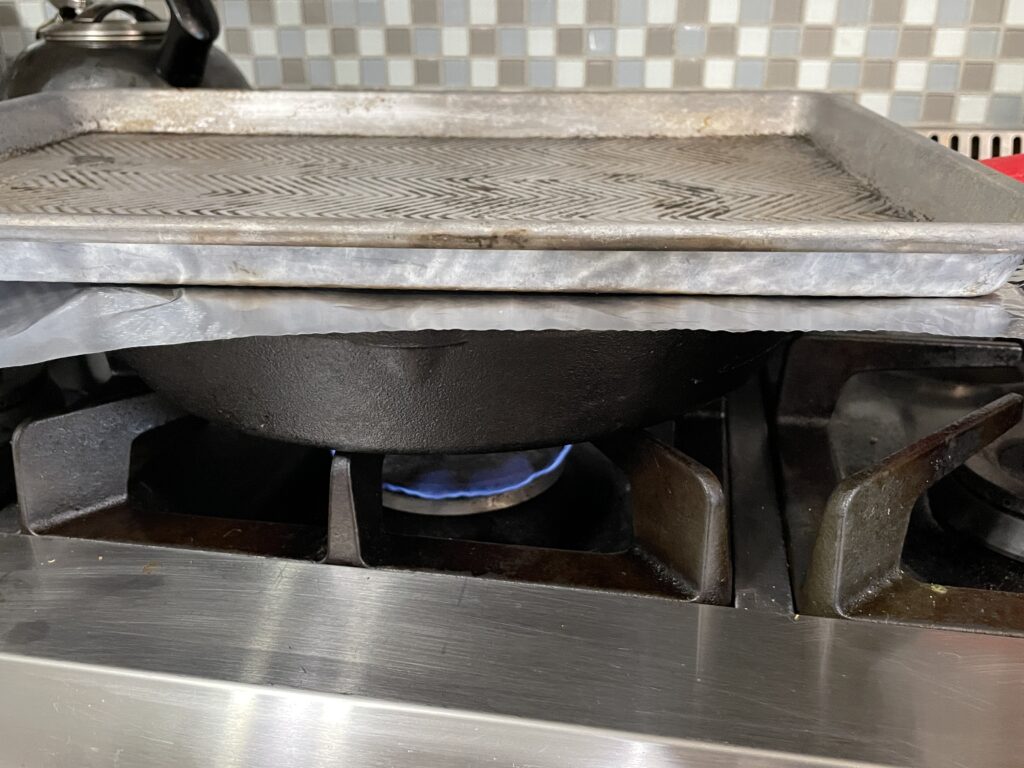So here I am, getting the ingredients out for the chicken cacciatore recipe I am working on, only to find out I don’t have canned whole tomatoes. Not a single can of diced, chopped, crushed, etc., but I did have fresh heirloom cherry tomatoes. If by chance you have to substitute fresh for canned tomatoes, I hope this little hint helps. I also added about ½ cup of water since I wouldn’t have the juice from the canned tomatoes.
- One 28-ounce can of tomatoes equals about 10 to 12 whole tomatoes, peeled (or about 2 pounds)
- One 14-1/2-ounce can of tomatoes equals 5 to 6 whole tomatoes, peeled (or about 1 pound)
Again, I used my huge cast iron skillet instead of the dutch oven that had a lid that fits. Once more, I had to use my makeshift lid. I think I need to look into getting a lid for this pan. It is quickly becoming one of my favorite pans to use.

Nothing fancy, just some aluminum foil and a cooking sheet to help keep it flat. Yes, I said cooking sheet and not cookie sheet, believe it or not those are two different things. But that is a story for another time.
I can thank Emeril Lagasse and Queen Latifa for turning me onto this dish. Bet you are wondering how that happened. It is not as fascinating as you may think, I was watching Last Holiday for like a billionth time, and in her book of ‘what ifs’ there is a picture of chicken cacciatore. At least that’s what I remember, I could be wrong. I was watching a lot of cooking shows at that time so it could be a mash-up of two memories. Either way, here we are now with a delicious recipe for chicken cacciatore.
I must be on an Italian kick lately, most of my recipes have been inspired by their foods. This is no different. Cacciatore means ‘hunter’ in Italian. In fact, it was thought that chicken wasn’t even used at first and that more game meats like rabbit and other wild game animals were used. If they came back empty handed, chickens from the farm or meat stall in the market would be used. This started during the Renaissance era around the 14th- 16th century.
As much as I love the lighter breast meat, this is a dish I would not recommend for it. Using the darker meat from the thighs and legs adds richness to the sauce and helps thicken it up. If you do use the white breast meat or another type of meat altogether, I would love to hear from you. I’m always looking to improve a dish and try something new and different.
Fun fact: did you know this dish is so popular it has its own day! Yes, that’s right, there is a National Chicken Cacciatore Day. October 15th is considered National Chicken Cacciatore Day, but don’t wait until then to try it!
Chicken Cacciatore
Heat a large Dutch oven or skillet over medium heat. Add the olive oil. Season the chicken pieces with salt and pepper. Add half the chicken and cook, skin side down, until crisp and browned. Turn the pieces over and cook another 5 minutes. Remove to a plate and continue browning in small batches until all chicken is browned. Reserve 1 tablespoon of the drippings in the pan.

Add the onions, mushrooms and a pinch of salt to the pan with the reserved drippings. Cook over medium-high heat until the vegetables begin to brown and the moisture evaporates.

Add the garlic and red pepper flakes to the pan and sauté until fragrant, about 30 seconds. Stir in the flour and continue cooking and stirring for 1 more minute. Add the wine, tomatoes, tomato paste, bay leaves, Parmesan rind, thyme, oregano and red bell pepper.

Remove the skin from the chicken and discard. Add the skinless chicken pieces to the pan, pressing them down into the sauce so they are covered. Bring to a boil, cover and reduce the heat to low. Simmer until the chicken is tender, about 40-45 minutes. Halfway through cooking, move the chicken pieces around and/or turn them over to ensure even cooking.
Remove the bay leaves and Parmesan rind and discard. Check seasoning and add salt and pepper if needed. Garnish with fresh chopped parsley leaves. Serve over hot cooked spaghetti or polenta.

Chicken Cacciatore
Ingredients
Instructions
